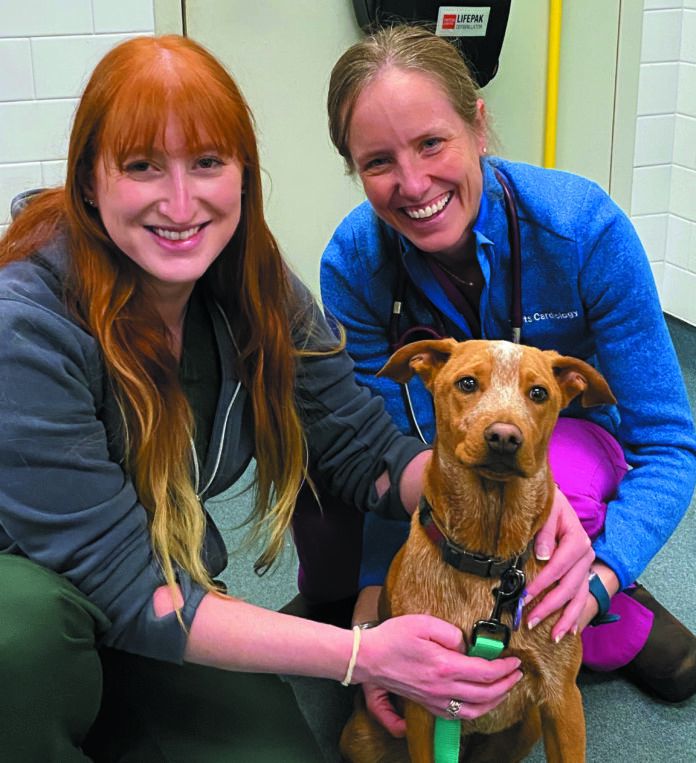When a developing puppy is growing inside his mother, he does not need to breathe. The oxygen he requires to mature in utero comes not from his lungs but from the umbilical cord. Thus, after coursing through the body, blood does not travel through the fetus’s lungs to pick up oxygen for another pump out to the body by the heart. The lungs remain deflated, and blood bypasses them through a kind of shunt called the ductus arteriosus.
However, the minute a puppy is born and takes his first breath, his lungs inflate. Blood has to start going through them to pick up oxygen from the air he breathes so it can be delivered by his pumping heart to his entire body. Mom’s umbilical cord isn’t there to supply the oxygen anymore.
In order for blood to go through the lungs rather than bypass them, the ductus arteriosus that has been open throughout the pregnancy squeezes shut for good. Unless it doesn’t. In that case, the puppy literally has a hole near his heart that hasn’t disappeared as it should, and his life is in danger. Called a patent (open) ductus arteriosus, or PDA, it’s one of the most common congenital heart defects to afflict dogs. If it’s not fixed within the first two years of a dog’s life, it’s usually fatal.
What happens is that blood is now able to make its way to the lungs for oxygen. But when it then comes over to the heart to be pumped out to the body, it flows backwards to the lungs through the wide-open shunt instead of getting sent by the heart to all the dog’s tissues. Affected dogs may become short of breath or exercise intolerant or may even experience a failure to thrive. The heart tries harder and harder to pump enough blood to the body, and the dog ends up with ever-worsening and life-threatening heart failure.
How the diagnosis goes
A dog with a PDA often doesn’t present with symptoms as a young puppy but has a very distinct heart murmur heard through a stethoscope upon routine examination. Some have described the murmur as sounding like an agitating washing machine.
Chest x-rays may also be ordered to look for fluid in the lungs that results from heart failure. The x-rays may show parts of the heart enlarged, too, because of the extra workout that muscular organ gets while trying to pump more blood to compensate for the fact that some of it has traveled back to the lungs. Finally, an echocardiogram — ultrasound of the heart — can see in real time what direction(s) blood is flowing in and whether any of it is “leaking” backwards towards the lungs when it should be moving forward from the heart to the rest of the body.
Treatment
If your puppy turns out to have a PDA, chances are that you will be referred to a veterinary cardiologist. Fortunately, there are a number of ways to treat the problem.
1. Do nothing. In rare cases, the hole with a PDA is small enough after an incomplete closure that backward blood flow is not significant and the cardiologist will recommend no treatment. The problem will not affect the dog over the course of his life.
2. Surgical ligation (closure). If the hole is large enough, the cardiologist may recommend an operation during which the open shunt is sutured shut. While opening the chest is required, dogs can tolerate this surgery well.
3. Minimally Invasive Endovascular Occlusion. Sometimes, the best option is to plug the hole. One device that does that is sort of like an umbrella that opens at both the top and bottom. It’s opened once it’s inside the duct and fits snugly on both ends, stopping blood from going in the wrong direction. The “plug” is put in place through the femoral artery — a blood vessel near the top of the dog’s lower extremities, specifically, on the inner thigh.
The good news is that whichever procedure is chosen, the dog typically goes on to live a normal life. The sooner it is done, the better. If congestive heart failure develops, it increases surgical risk or may even render repair of the PDA impossible.
Because of the expert care of Tufts veterinary cardiologist Emily Karlin, DVM (right) and veterinary cardiology resident Joey N. LaMastro, VMD, cattle dog George no longer has a hole by his heart that was making him very ill.





